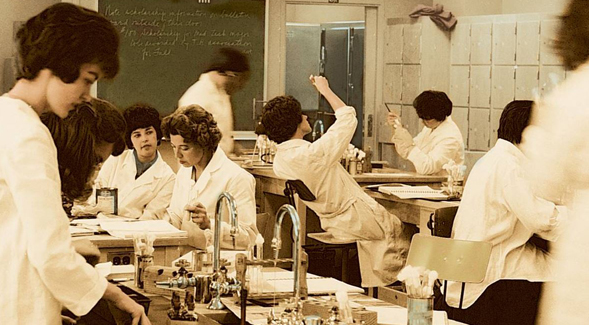The History of SDSU Research: Founding-1970
The universitys research strengths have deep roots in history.

This is the first installment in a series detailing SDSU’s history in the field of research.
The seeds of San Diego State University’s current research success can be traced back to the school’s earliest days. Since its incarnation as a teacher-training institution known as the San Diego Normal School, the university has grown into a top public research university. Today, SDSU is an economic driver of San Diego, as well as a primary source for the region's workforce.
1897 – Research a priority from the start
The San Diego Normal School, a training facility for elementary school teachers, opened its doors in downtown San Diego in 1897. The curriculum was limited at first to English, history and mathematics. In 1931, the institution moved to its current location, allowing the expansion of teaching and research activities. For example, geology professor Baylor Brooks took his students out to learn fieldwork techniques in the then-unpopulated hills and canyons surrounding campus.
1943 – Research foundation created
Established in 1943, the SDSU Research Foundation has furthered the educational, research and community service objectives of the university.
1950s – More stringent requirements for faculty
The university established a hiring policy requiring that all new faculty members have a doctorate degree, or be within a year of finishing one. It was a first-of-its-kind requirement for a California state college, and it resulted in a majority of San Diego State professors holding Ph.D.s by the early 1950s.
1953 – First major research award granted
The inaugural chair of the chemistry department, Ambrose Nichols, was one of the earliest faculty members to receive a major research award. An alumnus of the Manhattan Project who helped develop the atomic bomb, Nichols received funding from the Atomic Energy Commission between 1953 and 1955 to carry out his research into the properties of chemical compounds like phosgene and manganese.
1959 – Master’s degrees offered
By the end of the 1950s, San Diego State College offered 30 master’s degree programs and boasted robust, well-funded research programs in several disciplines including chemistry, physics, psychology, biology and mathematics.
1960 – Legislation temporarily thwarts ambitions
The college’s research ambitions were dealt a blow when the state passed the Donahoe Act, creating a tiered system of higher education among California's public universities. The right to independently offer Ph.D. degrees was reserved for the University of California system, while the California State College system could award doctoral degrees only in conjuction with an approved institution. While the state legislature may have intended for San Diego State College to limit its ambitions to teaching at the undergraduate level, SDSC officials and faculty had grander ideas. President Malcolm A. Love stated, “Our primary aim is teaching, but research is concomitant.”
1963 – JFK receives honorary doctorate
In 1963, just months before he was assassinated, President John F. Kennedy gave the commencement address at San Diego State College and received the institution's first honorary doctorate. According to Seth Mallios, university history curator, "The event was essential to striking down the prevalent reluctance to partner with a state college on a doctoral degree."
1967 – First Ph.D.
Partnering with the University of California, San Diego, the university conferred its first Ph.D., in chemistry, to Robert P. Metzger, now an SDSU emeritus professor.
1968 – Mount Laguna Observatory Opens
Established with funds from the National Science Foundation, the Mount Laguna Observatory sits at an elevation of 6,100 feet and remains one of the top dark-sky destinations in the southwestern United States. It has been the site of numerous astronomical discoveries.
For a complete view of the university's research history, visit our interactive timeline.


